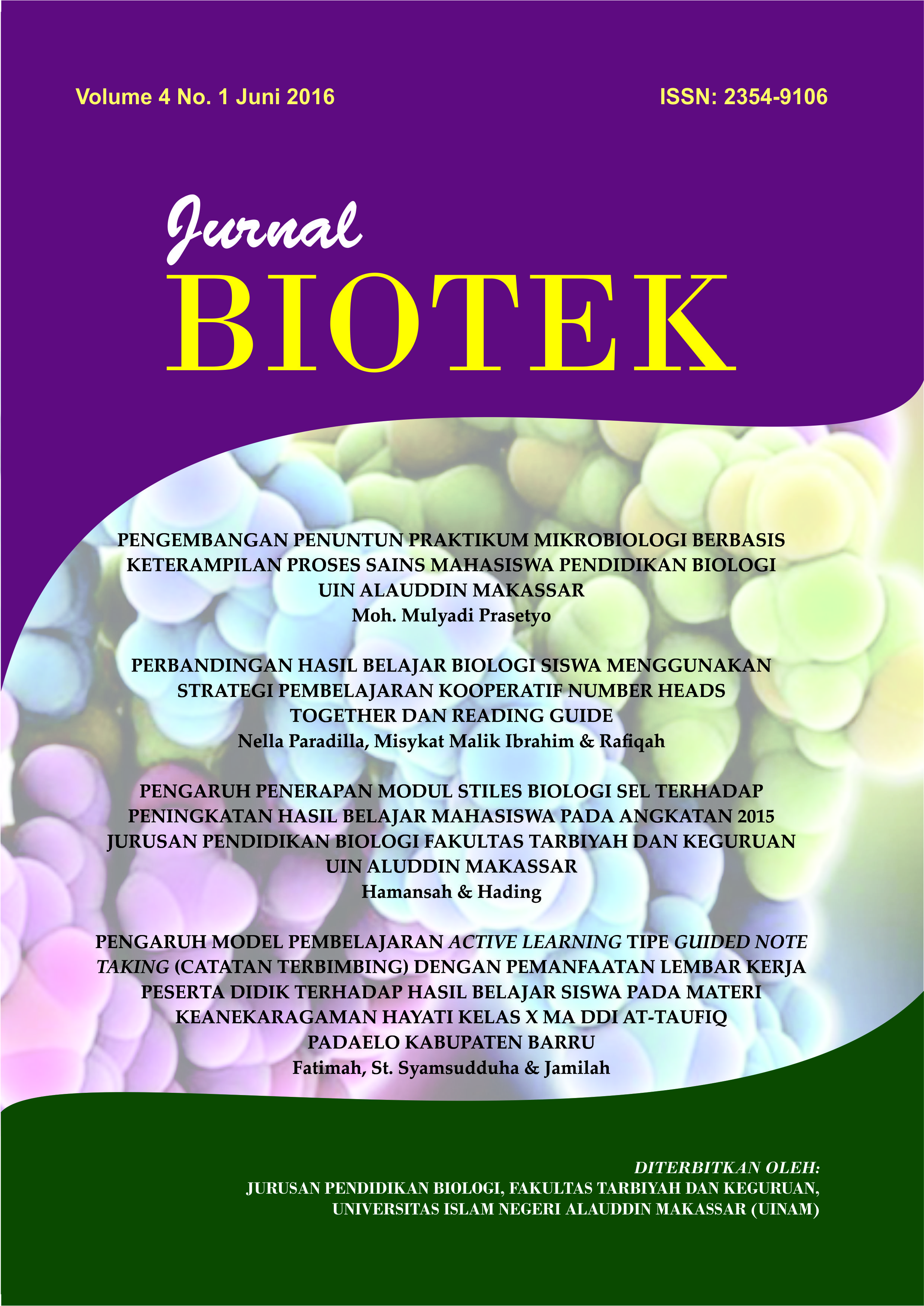PERBANDINGAN HASIL BELAJAR PESERTA DIDIK MATERI INDERA PENDENGARAN MANUSIA DENGAN MENGGUNAKAN METODE SQ3R DAN SQ4R KELAS VIII DI SMP NEGERI 1 PALLANGGA KABUPATEN GOWA
Abstrak
The problems in this study were (1) How the learning outcome of students using SQ3R (Survey, Question, Read, Recite, and Review), on the sense of human auditory material in the class VIII SMP Negeri 1 Pallangga Kab. Gowa, (2) How does the learning outcome of students using SQ4R (Survey, Question, Read, Reflect, Recite, and Review), on the sense of human auditory material in the class VIII SMP Negeri 1 Pallangga Kab. Gowa, and (3) Are there differences in learning outcomes of students using SQ3R (Survey, Question, Read, Recite, and Review), and using methods SQ4R (Survey, Question, Read, Reflect, Recite, and Review) on the sense of human auditory senses material in the class VIII SMP Negeri 1 Pallangga Kab. Gowa.
This study is a Quasi-Experimental Research Design with Posttest Only Control Design. In this design there are two groups and each use one of the treatment. The sampling technique used in this research is purposive sampling technique. The population in this study was all students of SMP Negeri 1 Pallangga Kab. Gowa with 325 students divided to of seven classes. The samples are class VIII6 and VIII7, each of class with 40 students. Data was collected using a test instrument with multiple choice questions of 20 questions and the observation sheet. Data analysis technique used is descriptive statistical analysis and inferential statistical analysis.
The results obtained in both groups through a descriptive statistical analysis, the average results of studying biology teaching methods SQ3R (Survey, Question, Read, Recite, and Review) is 57.98 while the average result of learning biology using strategies SQ4R learning (Survey, Question, Read, Reflect, Recite, and Review) is 61.37. The results of inferential analysis data show that significant value obtained is tcount 48.42> ttable 2,000 and significance (0.000 <0.05). It can be concluded that there is a difference in learning using method SQ3R (Survey, Question, Read, Recite, and Review) and method SQ4R (Survey, Question, Read, Reflect, Ricite, and Review) to the learning outcomes of Biology in the sense of the human auditory material in the class VIII SMP Negeri 1 Pallangga Kab. Gowa.
##plugins.generic.usageStats.downloads##
Referensi
Djamarah, Syaiful Bahri. (2010). Strategi Belajar Mengajar. Cet. II; Jakarta: Rineka Cipta.
Departemen Agama R.I., Al-Qur`an dan Terjemahnya (dalam berbagai edisi)
Hasbullah. (2008). Dasar-Dasar Ilmu Pendidikan, Cet. III; Jakarta: Raja Grafindo.
Indonesia Republik. (1992). “Undang-undang R.I. Nomor 2 Tahun 11989 pasal 4 Tentang Sistem Pendidikan Nasional”, Jakarta: Dirjend Bimbaga Islam, 1992.
Ihsan, Fuad, (2005). Dasar-Dasar Kependidikan. Jakarta: Rineka Cipta.
Mustami, Khalifah. (2015). Metodologi Penelitian Pendidikan. Yogyakarta: CV. Arti Bumi Intaran.
Syah, Muhibbin. (2013). Psikologi Belajar. Bandung: PT Remaja Rosdakarya.
Mulyatingsih, Endang. (2012). Metode Penelitian Terapan Bidang Pendidikan. Bandung: Alfabeta.
Nuryani. (2005). Strategi Belajar Mengajar Biologi. Malang: UM Press.
Sanjaya, Wina. (2013). Strategi Pembelajaran Berorientasi Standar Proses Pendidikan. Jakarta: Kencana Prenadamedia Group.
Slameto. (2010). Belajar dan Faktor- Faktor yang Mempengaruhinya. Jakarta: Rineka Cipta.
Sudjana, Nana. (2010). Penelitian dan Penilaian Pendidikan. Bandung: Sinar Baru Algensindo.
Sudijono, Anas. (2009). Evaluasi Pendidikan. Jakarta: Rajawali Pers.
Sagala, Syaiful. (2003). Konsep dan Makna Pembelajaran. Bandung: CV Alfabeta
Slavin, Robert E. (2010). Psikologi Pendidikan Teori dan Praktik. Jakarta: Indeks.
Authors who publish with Jurnal Biotek agree to the following terms: Authors retain the copyright and grant Universitas Islam Negeri Alauddin Makassar right of first publication with the work simultaneously licensed under a Creative Commons Attribution License (CC BY-SA 4.0) that allows others to share (copy and redistribute the material in any medium or format) and adapt (remix, transform, and build upon the material) the work for any purpose, even commercially with an acknowledgement of the work's authorship and initial publication in Universitas Islam Negeri Alauddin Makassar. Authors are able to enter into separate, additional contractual arrangements for the non-exclusive distribution of the journal's published version of the work (e.g., post it to an institutional repository or publish it in a book), with an acknowledgement of its initial publication in Universitas Islam Negeri Alauddin Makassar. Authors are permitted and encouraged to post their work online (e.g., in institutional repositories or on their website) prior to and during the submission process, as it can lead to productive exchanges, as well as earlier and greater citation of published work (See The Effect of Open Access).

This work is licensed under a Creative Commons Attribution-ShareAlike 4.0 International License.



